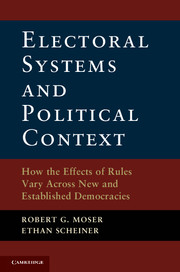 Electoral Systems and Political Context
Electoral Systems and Political Context Book contents
- Frontmatter
- Contents
- Tables and Figures
- Abbreviations
- Glossary of Key Terms
- Acknowledgments and Note on the Online Appendix
- Introduction
- 1 When Do the Effects of Electoral Systems Diverge from Our Expectations?
- 2 Mixed-Member Electoral Systems
- 3 How Democratic Experience and Party System Development Condition the Effects of Electoral Rules on Disproportionality and the Number of Parties
- 4 How Democratic Experience and Party System Development Condition the Effects of Electoral Rules on Disproportionality and the Number of Parties
- 5 Political Context, Electoral Rules, and Their Effects on Strategic and Personal Voting
- 6 How Democratic Experience and Party System Development Condition the Effect of Electoral Rules on Strategic Defection
- 7 Social Diversity, Electoral Rules, and the Number of Parties
- 8 How Political Context Shapes the Effect of Electoral Rules on Women's Representation
- 9 Conclusion
- References
- Index
1 - When Do the Effects of Electoral Systems Diverge from Our Expectations?
Published online by Cambridge University Press: 05 November 2012
- Frontmatter
- Contents
- Tables and Figures
- Abbreviations
- Glossary of Key Terms
- Acknowledgments and Note on the Online Appendix
- Introduction
- 1 When Do the Effects of Electoral Systems Diverge from Our Expectations?
- 2 Mixed-Member Electoral Systems
- 3 How Democratic Experience and Party System Development Condition the Effects of Electoral Rules on Disproportionality and the Number of Parties
- 4 How Democratic Experience and Party System Development Condition the Effects of Electoral Rules on Disproportionality and the Number of Parties
- 5 Political Context, Electoral Rules, and Their Effects on Strategic and Personal Voting
- 6 How Democratic Experience and Party System Development Condition the Effect of Electoral Rules on Strategic Defection
- 7 Social Diversity, Electoral Rules, and the Number of Parties
- 8 How Political Context Shapes the Effect of Electoral Rules on Women's Representation
- 9 Conclusion
- References
- Index
Summary
It is widely agreed that electoral rules matter. When polities adopt new rules to govern their elections, they usually have a specific effect in mind. At the most basic level, when electoral system engineers choose electoral rules, they do so with the understanding that first-past-the-post (FPTP) single-member district (SMD) systems tend to constrain the number of parties and perhaps even promote a competitive two-party system. When electoral rule designers want to encourage the presence of multiple parties – which, ideally, will provide clear, distinct representation to many different groups in society – they usually institute proportional representation (PR) rules, which allocate to parties a proportion of the total seats that matches their proportion of the total vote. It is also widely believed that electoral rules matter in numerous areas beyond simply the number of parties. Among the most important is the type of people who get elected to office – for example, it is presumed that a side benefit of closed-list PR rules is that they tend to help elect women to public office.
In many cases, political outcomes match the expectations electoral rule designers have for their systems – but often they do not. The recent experience of countries that have adopted mixed-member electoral systems offers very clear examples of FPTP and PR electoral rules having their expected effects under certain conditions, but also other instances when electoral rules fail to promote those outcomes. In the early 1990s, numerous countries instituted mixed-member system rules, with the most common type being electoral rules that offered voters two ballots – one for a candidate in an SMD and one for a party in closed-list PR. In countries such as Germany, Italy, Japan, and New Zealand that used these mixed-member systems, SMD balloting constrained the number of parties competing, whereas under PR, votes and seats were spread more evenly across a larger number of parties. There was also a difference in the types of people elected under the different types of rules in Germany, Italy, Japan, and New Zealand. Most notably, larger numbers of women were elected under PR rules than in SMDs.
- Type
- Chapter
- Information
- Electoral Systems and Political ContextHow the Effects of Rules Vary Across New and Established Democracies, pp. 13 - 41Publisher: Cambridge University PressPrint publication year: 2012


